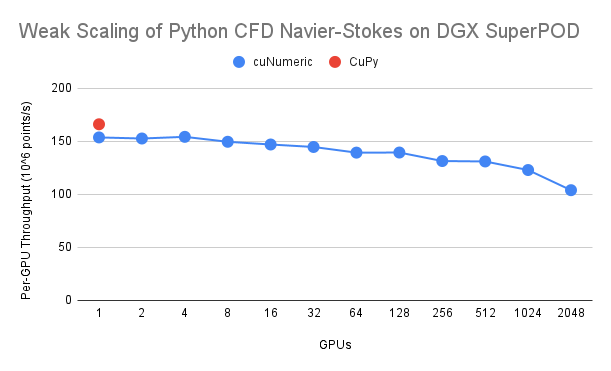cuNumeric is a Legate library that aims to provide a distributed and accelerated drop-in replacement for the NumPy API on top of the Legion runtime. Using cuNumeric you do things like run the final example of the Python CFD course completely unmodified on 2048 A100 GPUs in a DGX SuperPOD and achieve good weak scaling.
cuNumeric works best for programs that have very large arrays of data that cannot fit in the memory of a single GPU or a single node and need to span multiple nodes and GPUs. While our implementation of the current NumPy API is still incomplete, programs that use unimplemented features will still work (assuming enough memory) by falling back to the canonical NumPy implementation.
If you have questions, please contact us at legate(at)nvidia.com.
- Installation
- Dependencies
- Building from Source
- Usage and Execution
- Supported and Planned Features
- Supported Types and Dimensions
- Documentation
- Future Directions
- Contributing
- Known Bugs
cuNumeric is available on conda:
conda install -c nvidia -c conda-forge -c legate cunumeric
Pre-built docker images containing all Legate libraries, as well as specialized install scripts for supported clusters are available on the quickstart repo.
Read on for general instructions on building cuNumeric from source.
Users must have a working installation of the Legate Core library prior to installing cuNumeric.
cuNumeric requires Python >= 3.6. We provide a conda environment file that installs all needed dependencies in one step. Use the following command to create a conda environment with it:
conda env create -n legate -f conda/cunumeric_dev.yml
Installation of cuNumeric is done with either setup.py for simple
uses cases or install.py for more advanced use cases. The most common
installation command is:
python setup.py --with-core <path-to-legate-core-installation>
This will build cuNumeric against the Legate Core installation and then
install cuNumeric into the same location. Users can also install cuNumeric
into an alternative location with the canonical --prefix flag as well.
python setup.py --prefix <install-dir> --with-core <path-to-legate-core-installation>
Note that after the first invocation of setup.py this repository will remember
which Legate Core installation to use and the --with-core option can be
omitted unless the user wants to change it.
Advanced users can also invoke install.py --help to see options for
configuring cuNumeric by invoking the install.py script directly.
Of particular interest to cuNumeric users will likely be the option for
specifying an installation of OpenBLAS to use.
If you already have an installation of OpenBLAS on your machine you can
inform the install.py script about its location using the --with-openblas flag:
python setup.py --with-openblas /path/to/open/blas/
Using cuNumeric as a replacement for NumPy is easy. Users only need to replace:
import numpy as np
with:
import cunumeric as np
These programs can then be run by the Legate driver script described in the Legate Core documentation.
legate cunumeric_program.py
For execution with multiple nodes (assuming Legate Core is installed with GASNet support)
users can supply the --nodes flag. For execution with GPUs, users can use the
--gpus flags to specify the number of GPUs to use per node. We encourage all users
to familiarize themselves with these resource flags as described in the Legate Core
documentation or simply by passing --help to the legate driver script.
cuNumeric is currently a work in progress and we are gradually adding support for additional NumPy operators. Unsupported NumPy operations will provide a warning that we are falling back to canonical NumPy. Please report unimplemented features that are necessary for attaining good performance so that we can triage them and prioritize implementation appropriately. The more users that report an unimplemented feature, the more we will prioritize it. Please include a pointer to your code if possible too so we can see how you are using the feature in context.
cuNumeric currently supports the following NumPy types: float16, float32, float64,
int16, int32, int64, uint16, uint32, uint64, bool, complex64, and complex128.
Legate currently also only works on up to 3D arrays at the moment. We're currently working
on support for N-D arrays. If you have a need for arrays with more than three
dimensions please let us know about it.
A complete list of available features can is provided in the API reference.
There are three primary directions that we plan to investigate with cuNumeric going forward:
- More features: we plan to identify a few key lighthouse applications and use the demands of these applications to drive the addition of new features to cuNumeric.
- We plan to add support for sharded file I/O for loading and storing large data sets that could never be loaded on a single node. Initially this will begin with native support for h5py but will grow to accommodate other formats needed by our lighthouse applications.
- Strong scaling: while cuNumeric is currently implemented in a way that enables weak scaling of codes on larger data sets, we would also like to make it possible to strong-scale Legate applications for a single problem size. This will require leveraging some of the more advanced features of Legion from inside the Python interpreter.
We are open to comments, suggestions, and ideas.
See the discussion of contributing in CONTRIBUTING.md.
- cuNumeric can exercise a bug in OpenBLAS when it is run with multiple OpenMP processors
- On Mac OSX, cuNumeric can trigger a bug in Apple's implementation of libc++. The bug has since been fixed but likely will not show up on most Apple machines for quite some time. You may have to manually patch your implementation of libc++. If you have trouble doing this please contact us and we will be able to help you.
